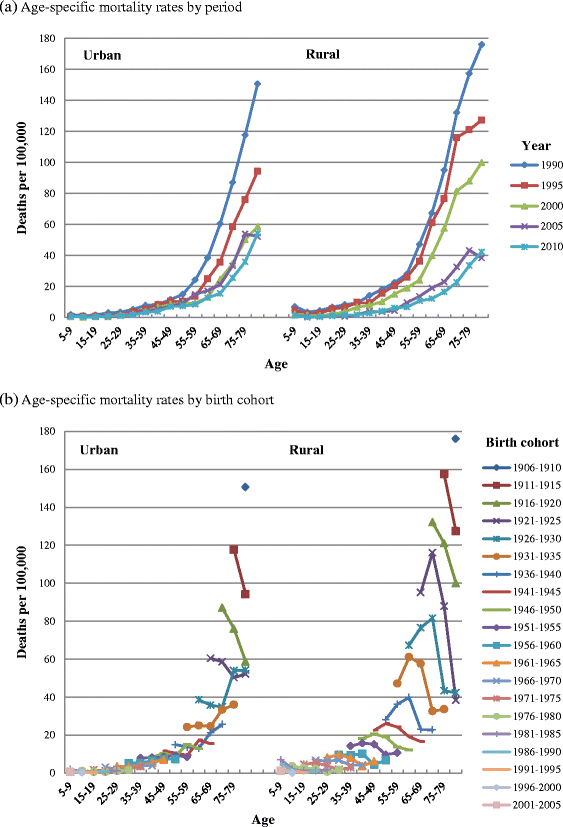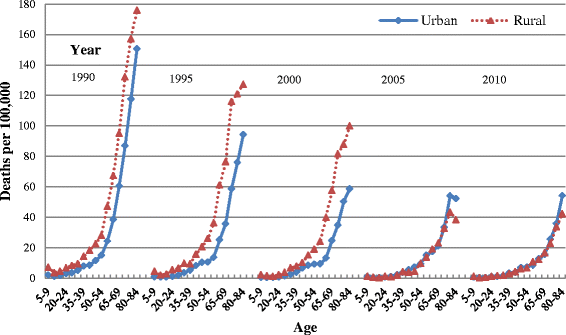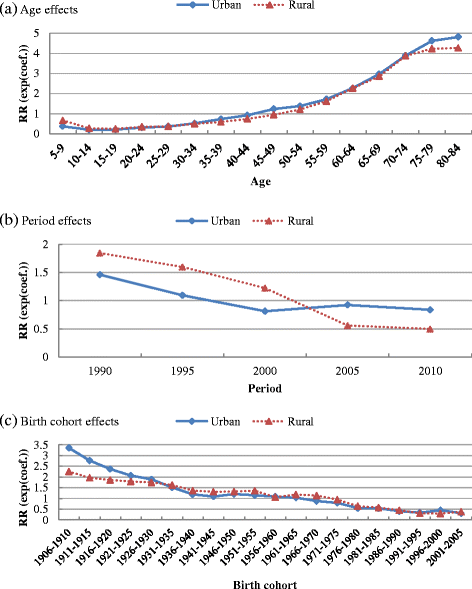Age-period-cohort analysis of infectious disease mortality in urban-rural China, 1990-2010
- PMID: 27036223
- PMCID: PMC4815076
- DOI: 10.1186/s12939-016-0343-7
Age-period-cohort analysis of infectious disease mortality in urban-rural China, 1990-2010
Abstract
Background: Although a number of studies on infectious disease trends in China exist, these studies have not distinguished the age, period, and cohort effects simultaneously. Here, we analyze infectious disease mortality trends among urban and rural residents in China and distinguish the age, period, and cohort effects simultaneously.
Methods: Infectious disease mortality rates (1990-2010) of urban and rural residents (5-84 years old) were obtained from the China Health Statistical Yearbook and analyzed with an age-period-cohort (APC) model based on Intrinsic Estimator (IE).
Results: Infectious disease mortality is relatively high at age group 5-9, reaches a minimum in adolescence (age group 10-19), then rises with age, with the growth rate gradually slowing down from approximately age 75. From 1990 to 2010, except for a slight rise among urban residents from 2000 to 2005, the mortality of Chinese residents experienced a substantial decline, though at a slower pace from 2005 to 2010. In contrast to the urban residents, rural residents experienced a rapid decline in mortality during 2000 to 2005. The mortality gap between urban and rural residents substantially narrowed during this period. Overall, later birth cohorts experienced lower infectious disease mortality risk. From the 1906-1910 to the 1941-1945 birth cohorts, the decrease of mortality among urban residents was significantly faster than that of subsequent birth cohorts and rural counterparts.
Conclusions: With the rapid aging of the Chinese population, the prevention and control of infectious disease in elderly people will present greater challenges. From 1990 to 2010, the infectious disease mortality of Chinese residents and the urban-rural disparity have experienced substantial declines. However, the re-emergence of previously prevalent diseases and the emergence of new infectious diseases created new challenges. It is necessary to further strengthen screening, immunization, and treatment for the elderly and for older cohorts at high risk.
Keywords: APC Model; IE; Infectious disease; Mortality; Urban- rural China.
Figures



Similar articles
-
Urban and rural stroke mortality rates in China between 1988 and 2013: An age-period-cohort analysis.J Int Med Res. 2017 Apr;45(2):680-690. doi: 10.1177/0300060516664241. Epub 2017 Mar 24. J Int Med Res. 2017. PMID: 28415926 Free PMC article.
-
The Trends in Cardiovascular Diseases and Respiratory Diseases Mortality in Urban and Rural China, 1990-2015.Int J Environ Res Public Health. 2017 Nov 15;14(11):1391. doi: 10.3390/ijerph14111391. Int J Environ Res Public Health. 2017. PMID: 29140293 Free PMC article.
-
Long-term trends of liver cancer mortality by gender in urban and rural areas in China: an age-period-cohort analysis.BMJ Open. 2018 Feb 8;8(2):e020490. doi: 10.1136/bmjopen-2017-020490. BMJ Open. 2018. PMID: 29439081 Free PMC article.
-
Policy Development on Upskilling/Reskilling Older Population Care Staff in China.Int J Environ Res Public Health. 2022 Aug 1;19(15):9440. doi: 10.3390/ijerph19159440. Int J Environ Res Public Health. 2022. PMID: 35954791 Free PMC article. Review.
-
Analysis of mortality decline along with age and latent congenital defects.Mech Ageing Dev. 2003 May;124(5):679-96. doi: 10.1016/s0047-6374(03)00063-0. Mech Ageing Dev. 2003. PMID: 12735907 Review.
Cited by
-
Prevalence and Risk Factors of Healthcare-Associated Infections among Hospitalized Pediatric Patients: Point Prevalence Survey in Thailand 2021.Children (Basel). 2024 Jun 17;11(6):738. doi: 10.3390/children11060738. Children (Basel). 2024. PMID: 38929317 Free PMC article.
-
Persistence and Variation of the Indirect Effects of COVID-19 Restrictions on the Spectrum of Notifiable Infectious Diseases in China: Analysis of National Surveillance Among Children and Adolescents From 2018 to 2021.JMIR Public Health Surveill. 2024 May 15;10:e47626. doi: 10.2196/47626. JMIR Public Health Surveill. 2024. PMID: 38748469 Free PMC article.
-
All-Cause and Cancer Mortality Trends in Macheng, China (1984⁻2013): An Age-Period-Cohort Analysis.Int J Environ Res Public Health. 2018 Sep 20;15(10):2068. doi: 10.3390/ijerph15102068. Int J Environ Res Public Health. 2018. PMID: 30241353 Free PMC article.
-
Sex-Specific Temporal Trends in Overweight and Obese Among Schoolchildren From 2009 to 2018: An Age Period Cohort Analysis.Front Pediatr. 2021 May 13;9:615483. doi: 10.3389/fped.2021.615483. eCollection 2021. Front Pediatr. 2021. PMID: 34055679 Free PMC article.
-
Trends in the Incidence and Mortality of Diabetes in China from 1990 to 2017: A Joinpoint and Age-Period-Cohort Analysis.Int J Environ Res Public Health. 2019 Jan 8;16(1):158. doi: 10.3390/ijerph16010158. Int J Environ Res Public Health. 2019. PMID: 30626127 Free PMC article.
References
-
- Hu LL, Hu AG. From unfair to fairer health development: the analysis and suggestions of Chinese urban and rural gap of disease pattern. Manage World. 2003;1:78–87.
MeSH terms
LinkOut - more resources
Full Text Sources
Other Literature Sources
Medical
Miscellaneous

